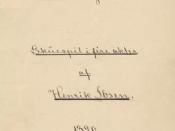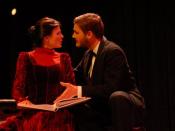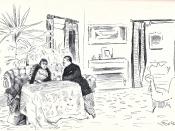A dramatist living in a society centered around social standards, Henrik Ibsen produced plays about his world as he saw it. With plays such as "The Doll House" and "Hedda Gabler," Isben gave audiences of the future a look into aspects of nineteenth-century Norwegian middle class life -- particularly the life of a married couples. In each of these two plays, individual couples are faced with trivial issues of great importance.
Each marriage possesses it's own circumstantial challenges and characteristics yet despite these differences each are plagued by one central plight: a wife's struggle to escape the grip of society.
In order to understand the plight of Hedda and Nora, one must examine the society in which they lived. The era was that of comfort and stability. Large parts of the society were indulging in the lavishness of aristocracy or enjoying the comfort of the middle class. These were stable times, and those enjoying them wanted life to stay this way.
To the Norwegians of the time, female motivated divorce was unheard of.
Many of the other themes and actions which take place in Ibsen's plays were considered outlandish and because of this, Ibsen's work was often faced with firm opposition. In retrospect, the challenges Ibsen faced now help solidify and illustrate those placed before Hedda and Nora.
Despite the similar hurdles Hedda and Nora face, the central setup and function of their marriages possess substantial differences, the most notable of which can be found when observing the female's roll in each marriage. In "A Doll House," Torvald and Nora Helmer barely communicate in a civil manner. Torvald constantly addresses Nora as his "squirrel" (44) and other pet names which carry with them condescending overtones. Torvald wishes to live the life of a middle class Norwegian male and...


